![]()
![]()
![]()
Use LEFT and RIGHT arrow keys to navigate between flashcards;
Use UP and DOWN arrow keys to flip the card;
H to show hint;
A reads text to speech;
170 Cards in this Set
- Front
- Back
|
What are the hallmarks of cancer?
|
- Evasion of apoptosis
- Growth signal self-sufficiency - Anti-growth signal insensitivity - Sustained angiogenesis - Limitless replicative potential - Tissue invasion - Metastasis |
|
|
What is the organization of normal epithelial cells in relation to the basement membrane?
|
Normal cells with basal → apical differentiation
|
|
|
What is the organization of epithelial cells in relation to the basement membrane undergoing hyperplasia?
|
Cells ↑ in number
|
|
|
What is the organization of epithelial cells in relation to the basement membrane undergoing dysplasia?
|
Abnormal proliferation of cells with loss of size, shape, and orientation
|
|
|
What is dysplasia?
|
Abnormal proliferation of cells with loss of size, shape, and orientation
|
|
|
What is the organization of epithelial cells in relation to the basement membrane undergoing carcinoma in situ?
|
- Neoplastic cells have not invaded basement membrane
- High nuclear / cytoplasmic ratio and clumped chromatin - Neoplastic cells encompass entire thickness |
|
|
What is the organization of epithelial cells in relation to the basement membrane undergoing invasive carcinoma?
|
- Cells have invaded basement membrane using collagenases and hydrolases (metalloproteinases)
- Can metastasize if they reach a blood or lymphatic vessel |
|
|
What is the mechanism by which cells invade the basement membrane in invasive carcinoma?
|
Collagenases and Hydrolases (Metalloproteinases)
|
|
|
What is necessary for cancerous cells to metastasize?
|
If they reach a blood or lymphatic vessel
|
|
|
What is the organization of epithelial cells in relation to the basement membrane undergoing metastasis?
|
Spread to distant organ
- Must survive immune attack - Seed and soil theory of metastasis |
|
|
What is the "seed" in the seed and soil theory of metastasis?
|
Tumor embolus
|
|
|
What is the "soil" in the seed and soil theory of metastasis?
|
Target organ: liver, lungs, bone, brain, etc
|
|
|
What is the multidrug resistance protein 1 (MDR1)?
|
P-glycoprotein
|
|
|
What is P-glycoprotein also known as? What cells express this?
|
AKA Multidrug Resistance Protein 1 (MDR1)
- Expressed by some cancer cells (eg, colon, liver) |
|
|
What is the function of P-glycoprotein?
|
Pumps out toxins, including chemotherapeutic agents (one mechanism of ↓ responsiveness or resistance to chemotherapy over time)
|
|
|
What is the term for an ↑ in the number of cells?
|
Hyperplasia
|
|
|
What is the term for an adult cell type being replaced by another? Cause?
|
Metaplasia
- Caused by irritation (eg, Barrett esophagus) and/or environmental exposure (eg, smoking-induced tracheal/bronchial squamous metaplasia) |
|
|
What is the term for abnormal growth with loss of cellular orientation, shape, and size in comparison to normal tissue maturation?
|
Dysplasia
- Commonly preneoplastic |
|
|
What is the term for the loss of structural differentiation and function of cells, resembling primitive cells of the same tissue?
|
Anaplasia
|
|
|
What happens in Anaplasia? What is it associated with?
|
- Loss of structural differentiation and function of cells, resembling primitive cells of same tissue
- Often equated with undifferentiated malignant neoplasms - May see giant cells with single large nucleus or several nuclei |
|
|
What is the term for a clonal proliferation of cells that is uncontrolled and excessive?
|
Neoplasia
- Benign of malignant |
|
|
What is the term for fibrous tissue formation in response to neoplasm?
|
Desmoplasia
|
|
|
What is an example of Desmoplasia?
|
Linitis plastica in diffuse stomach cancer
|
|
|
What determines the tumor grade?
|
Determined by degree of cellular differentiation and mitotic activity on histology
|
|
|
What do the tumor grades mean?
|
Graded 1-4:
- 1 = low grade, well differentiated - 4 = high grade, poorly differentiated, anaplastic |
|
|
Which has more prognostic value: tumor grade or stage?
|
Tumor stage has more prognostic value
|
|
|
What determines the tumor stage?
|
Stage = Spread
- Degree of localization / spread based on site and size of primary lesion, spread to regional lymph nodes, and presence of metastases - Based on clinical (c) or pathology (p) findings |
|
|
What is the tumor staging system?
|
- T = Tumor size
- N = Nodal involvement - M = Metastases TMN each has independent prognostic value |
|
|
What is the difference between carcinoma and sarcoma?
|
Both imply malignancy
- Carcinoma: epithelial origin, spreads lymphatically - Sarcoma: mesenchymal origin, spreads hematogenously |
|
|
Which type of malignancy originates from epithelial tissue?
|
Carcinoma
|
|
|
Which type of malignancy originates from mesenchymal tissue?
|
Sarcoma
|
|
|
Which type of malignancy spreads hematogenously?
|
- Sarcomas
- Renal cell carcinoma (renal vein invasion), hepatocellular carcinoma (hepatic vein invasion), follicular carcinoma of the thyroid, and choriocarcinoma |
|
|
Which type of malignancy spreads lymphatically?
|
Carcinomas (exception: renal cell carcinoma, hepatocellular carcinoma, follicular carcinoma of thyroid, and choriocarcinoma spread hematogenously)
|
|
|
What are the types of benign epithelial tumors?
|
Adenoma and Papilloma
|
|
|
What are the types of malignant epithelial tumors?
|
Adenocarcinoma and Papillary Carcinoma
|
|
|
What are the types of malignant blood cell tumors?
|
Leukemia and Lymphoma
|
|
|
What are the types of benign blood vessel tumors?
|
Hemangioma
|
|
|
What are the types of malignant blood vessel tumors?
|
Angiosarcoma
|
|
|
What are the types of benign smooth muscle tumors?
|
Leiomyoma
|
|
|
What are the types of malignant smooth muscle tumors?
|
Leiomyosarcoma
|
|
|
What are the types of benign striated muscle tumors?
|
Rhabdomyoma
|
|
|
What are the types of malignant striated muscle tumors?
|
Rhabdomyosarcoma
|
|
|
What are the types of benign connective tissue tumors?
|
Fibroma
|
|
|
What are the types of malignant connective tissue tumors?
|
Fibrosarcoma
|
|
|
What are the types of benign bone tumors?
|
Osteoma
|
|
|
What are the types of malignant bone tumors?
|
Osteosarcoma
|
|
|
What are the types of benign fat tumors?
|
Lipoma
|
|
|
What are the types of malignant fat tumors?
|
Liposarcoma
|
|
|
What are the typical characteristics of benign tumors?
|
- Usually well differentiated
- Low mitotic activity - Well demarcated - No metastasis - No necrosis |
|
|
What are the typical characteristics of malignant tumors?
|
- May be poorly differentiated
- Erratic growth - Locally invasive / diffuse - May metastasize - ↓ Apoptosis (upregulation of telomerase prevents chromosome shortening and cell death) |
|
|
What is the term for weakness and wasting of the body due to severe chronic illness?
|
Cachexia
|
|
|
What are the signs of cachexia?
|
- Weight loss
- Muscle atrophy - Fatigue |
|
|
What causes cachexia?
|
Chronic diseases: cancer, AIDS, heart failure, TB
- Mediated by TNF-α (nicknamed cachectin), IFN-γ, and IL-6 |
|
|
What inflammatory markers mediate cachexia?
|
- TNF-α (cachechtin)
- IFN-γ - IL-6 |
|
|
What neoplasm is associated with acanthosis nigricans (hyperpigmentation and epidermal thickening)?
|
Visceral malignancies (especially stomach)
|
|
|
What neoplasm is associated with actinic keratosis?
|
Squamous cell carcinoma of skin
|
|
|
What neoplasms are associated with AIDS?
|
- Aggressive malignant lymphomas (non-Hodgkin)
- Kaposi sarcoma |
|
|
What neoplasm is associated with auto-immune diseases (eg, Hashimoto thyroiditis, SLE)?
|
Lymphoma
|
|
|
What neoplasm is associated with Barrett esophagus (chronic GI reflux)?
|
Esophageal adenocarcinoma
|
|
|
What neoplasm is associated with chronic atrophic gastritis?
|
Gastric Adenocarcinoma
|
|
|
What neoplasm is associated with pernicious anemia?
|
Gastric Adenocarcinoma
|
|
|
What neoplasm is associated with post-surgical gastric remnants?
|
Gastric Adenocarcinoma
|
|
|
What neoplasm is associated with cirrhosis?
|
Hepatocellular Carcinoma
|
|
|
What neoplasm is associated with Cushing syndrome?
|
Small cell lung cancer
|
|
|
What neoplasm is associated with dermatomyositis?
|
Lung cancer
|
|
|
What neoplasms are associated with Down Syndrome?
|
- ALL ("we ALL fall DOWN"
- AML |
|
|
What neoplasm is associated with a Dysplastic Nevus?
|
Malignant Melanoma
|
|
|
What neoplasm is associated with hypercalcemia?
|
Squamous cell lung cancer
|
|
|
What neoplasm is associated with immunodeficiency states?
|
Malignant lymphomas
|
|
|
What neoplasm is associated with Lambert-Eaton myasthenic syndrome?
|
Small cell lung cancer
|
|
|
What neoplasm is associated with myasthenia gravis?
|
Thymoma
|
|
|
What neoplasm is associated with a pure RBC aplasia?
|
Thymoma
|
|
|
What neoplasms are associated with Paget disease of bone?
|
- Secondary osteosarcoma
- Fibrosarcoma |
|
|
What neoplasm is associated with Plummer-Vinson Syndrome (↓ iron)?
|
Squamous cell carcinoma of esophagus
|
|
|
What neoplasms are associated with polycythemia?
|
- Renal cell carcinoma
- Hepatocellular carcinoma |
|
|
What neoplasms are associated with radiation exposure?
|
- Leukemia
- Sarcoma - Papillary thyroid cancer - Breast cancer |
|
|
What neoplasm is associated with SIADH?
|
Small cell lung cancer
|
|
|
What neoplasms are associated with tuberous sclerosis (facial angiofibroma, seizures, intellectual disability)?
|
- Giant cell astrocytoma
- Renal angiomyolipoma - Cardiac rhabdomyoma |
|
|
What neoplasm is associated with ulcerative colitis?
|
Colonic adenocarcinoma
|
|
|
What neoplasms are associated with xeroderma pigmentosum and albinism?
|
- Melanoma
- Basal cell carcinoma - Especially squamous cell carcinoma of skin |
|
|
What happens to activate an oncogene?
|
Gain of function → ↑ cancer risk
Need damage to only 1 allele |
|
|
What are the types of oncogenes?
|
- BCR-ABL
- bcl-2 - BRAF - c-kit - c-myc - HER2/neu (c-erbB2) - L-myc - N-myc - ras - ret |
|
|
What happens to activate a tumor suppressor gene?
|
Loss of function → ↑ cancer risk
Both alleles must be lost for expression of disease |
|
|
What are the types of tumor suppressor genes?
|
- APC
- BRCA1 and BRCA2 - CPD4/SMAD4 - DCC - MEN1 - NF1 and NF2 - p16 - p53 - PTEN - Rb - TSC1 and TSC2 - VHL - WT1 and WT2 |
|
|
What is the associated tumor and gene product of BCR-ABL?
|
BCR-ABL (oncogene)
- Associated with CML and ALL - Gene product: tyrosine kinase |
|
|
What is the associated tumor and gene product of bcl-2?
|
bcl-2 (oncogene)
- Associated with follicular and undifferentiate lymphomas - Gene product: anti-apoptotic molecule (inhibits apoptosis) |
|
|
What is the associated tumor and gene product of BRAF?
|
BRAF (oncogene)
- Associated with melanoma - Gene product: serine / threonine kinase |
|
|
What is the associated tumor and gene product of c-kit?
|
c-kit (oncogene)
- Associated with gastrointestinal stromal tumor (GIST) - Gene product: cytokine receptor (for stem cell factor) |
|
|
What is the associated tumor and gene product of c-myc?
|
c-myc (oncogene)
- Associated with Burkitt lymphoma - Gene product: cytokine receptor (for stem cell factor) |
|
|
What is the associated tumor and gene product of HER2/neu (c-erbB2)?
|
HER2/neu (oncogene)
- Associated with breast, ovarian, and gastric carcinomas - Gene product: tyrosine kinase |
|
|
What is the associated tumor and gene product of L-myc?
|
L-myc (oncogene)
- Associated with lung tumor - Gene product: transcription factor |
|
|
What is the associated tumor and gene product of N-myc?
|
N-myc (oncogene)
- Associated with neuroblastoma - Gene product: transcription factor |
|
|
What is the associated tumor and gene product of ras?
|
Ras (oncogene)
- Associated with colon cancer, lung cancer, and pancreatic cancer - Gene product: GTPase |
|
|
What is the associated tumor and gene product of ret?
|
Ret (oncogene)
- Associated with MEN 2A and 2B - Gene product: tyrosine kinase |
|
|
What tumor is associated with APC?
|
APC (tumor suppressor)
- Associated with colorectal cancer (associated with FAP) |
|
|
What is the associated tumor and gene product of BRCA1 and BRCA2?
|
BRCA1 and BRCA2 (tumor suppressor)
- Associated with breast and ovarian cancer - Gene product: DNA repair protein |
|
|
What is the associated tumor and gene product of CPD4/SMAD4?
|
CPD4/SMAD4 (tumor suppressor)
- Associated with pancreatic cancer - Gene product: DPC = Deleted in Pancreatic Cancer |
|
|
What is the associated tumor and gene product of DCC?
|
DCC (tumor suppressor)
- Associated with colon cancer - Gene product: DCC = Deleted in Colon Cancer |
|
|
What is the associated tumor and gene product of NF1?
|
NF1 (tumor suppressor)
- Associated with Neurofibromatosis type 1 - Gene product: RAS GTPase activating protein (neurofibromin) |
|
|
What is the associated tumor and gene product of NF2?
|
NF2 (tumor suppressor)
- Associated with Neurofibromatosis type 2 - Gene product: Merlin (schwannomin) protein |
|
|
What is the associated tumor and gene product of p16?
|
p16 (tumor suppressor)
- Associated with melanoma - Gene product: cyclin-dependent kinase inhibitor 2A |
|
|
What is the associated tumor and gene product of p53?
|
p53 (tumor suppressor)
- Associated with most human cancers and Li-Fraumeni syndrome - Gene product: transcription factor for p21, blocks G1 → S phase |
|
|
What tumor is associated with PTEN?
|
PTEN (tumor suppressor)
- Associated with breast cancer, prostate cancer, and endometrial cancer |
|
|
What is the associated tumor and gene product of Rb?
|
Rb (tumor suppressor)
- Associated with retinoblastoma and osteosarcoma - Gene product: inhibits E2F, blocks G1 → S phase |
|
|
What is the associated tumor and gene product of TSC1?
|
TSC1 (tumor suppressor)
- Associated with tuberous sclerosis - Gene product: Hamartin protein |
|
|
What is the associated tumor and gene product of TSC2?
|
TSC2 (tumor suppressor)
- Associated with tuberous sclerosis - Gene product: Tuberin protein |
|
|
What is the associated tumor and gene product of VHL?
|
VHL (tumor suppressor)
- Associated with von Hippel-Lindau disease - Gene product: inhibits hypoxia inducible factor 1a |
|
|
What tumor is associated with WT1 and WT2?
|
WT1 and WT2 (tumor suppressor genes)
- Associated with Wilms Tumor (nephroblastoma) |
|
|
What is the use and limitations of "tumor markers"?
|
- Should not be used as the primary tool for cancer diagnosis
- They may be used to monitor tumor recurrence and response to therapy, but definitive diagnosis can be made only via biopsy |
|
|
What is alkaline phosphatase a tumor marker of?
|
Metastases to bone, liver, Paget disease of bone, and seminoma (placental ALP)
|
|
|
What is α-Fetoprotein a tumor marker of?
|
- Normally made by fetus
- Hepatocellular carcinoma, hepatoblastoma, yolk sac (endodermal sinus) tumor, testicular cancer, mixed germ cell tumor (co-secreted with β-hCG) |
|
|
What is β-hCG a tumor marker of?
|
- Hydatidiform moles and Choriocarcinoma (gestational trophoblastic disease), and testicular cancer
- Commonly associated with pregnancy |
|
|
What is CA-15-3/CA-27-29 a tumor marker of?
|
Breast cancer
|
|
|
What is CA-19-9 a tumor marker of?
|
Pancreatic adenocarcinoma
|
|
|
What is CA-125 a tumor marker of?
|
Ovarian cancer
|
|
|
What is calcitonin a tumor marker of?
|
Medullary thyroid carcinoma
|
|
|
What is CEA a tumor marker of?
|
CarcinoEmbryonic Antigen
- Very non-specific but produced by ~70% of colorectal and pancreatic cancers - Also produced by gastric, breast, and medullary thyroid carcinomas |
|
|
What is PSA a tumor marker of?
|
Prostate Specific Antigen
- Used to follow prostate adenocarcinoma - Can also be elevated in BPH and prostatitis - Questionable risk/benefit for screening |
|
|
What is S-100 a tumor marker of?
|
Neural crest origin (eg, melanoma, neural tumors, schwannomas, Langerhans cell histiocytosis)
|
|
|
What is TRAP a tumor marker of?
|
Tartrate-Resistant Acid Phosphatase (TRAP)
- Hairy cell leukemia (B-cell neoplasm) "TRAP the hairy animal - largely replaced by flow cytometry" |
|
|
What cancers are associated with EBV?
|
- Burkitt lymphoma
- Hodgkin lymphoma - Nasopharyngeal carcinoma - CNS lymphoma (in immunocompromised patients) |
|
|
What cancers are associated with HBV and HCV?
|
Hepatocellular Carcinoma
|
|
|
What cancers are associated with HHV-8?
|
Kaposi-Sarcoma associated herpesvirus
- Body cavity fluid B-cell lymphoma |
|
|
What cancers are associated with HPV?
|
Cervical and penile/anal carcinoma (16, 18)
- Head and neck or throat cancer |
|
|
What cancers are associated with H. pylori?
|
Gastric adenocarcinoma and MALT lymphoma
|
|
|
What cancers are associated with HTLV-1?
|
Adult T-cell Leukemia / Lymphoma
|
|
|
What cancers are associated with liver flukes (Clonorchis sinensis)?
|
Cholangiocarcinoma
|
|
|
What cancers are associated with Schistosoma haematobium?
|
Bladder cancer (squamous cell)
|
|
|
What organ does Aspergillus affect? How?
|
Aspergillus releases Aflatoxins → Liver → Hepatocellular Carcinoma
|
|
|
What organ do Alkylating Agents affect? How?
|
Alkylating agents → Blood → Leukemia / Lymphoma
|
|
|
What organ do Aromatic Amines (eg, Benzidine, 2-Naphthylamine) affect? How?
|
Aromatic Amines → Bladder → Transitional Cell Carcinoma
|
|
|
What organ does Arsenic affect? How?
|
Arsenic:
- Liver → Angiosarcoma - Lung → Lung cancer - Skin → Squamous cell carcinoma |
|
|
What organ does Asbestos affect? How?
|
Asbestos → Lung → Bronchogenic Carcinoma > Mesothelioma
|
|
|
What organ does Carbon Tetrachloride affect? How?
|
Carbon Tetrachloride → Liver → Centrilobular Necrosis and Fatty change
|
|
|
What organ does cigarette smoke affect? How?
|
Cigarette smoke:
- Bladder → Transitional cell carcinoma - Esophagus → Squamous cell carcinoma / Adenocarcinoma - Kidney → Renal cell carcinoma - Larynx → Squamous cell carcinoma - Lung → Squamous cell and small cell carcinoma - Pancreas → Pancreatic adenocarcinoma |
|
|
What organ do Ethanol affect? How?
|
Ethanol → Liver → Hepatocellular carcinoma
|
|
|
What organ does ionizing radiation affect? How?
|
Ionizing Radiation → Thyroid → Papillary Thyroid Carcinoma
|
|
|
What organ do Nitrosamines (smoked foods) affect? How?
|
Nitrosamines → Stomach → Gastric cancer
|
|
|
What organ does Radon affect? How?
|
Radon → Lung → Lung Cancer (2nd leading cause after cigarette smoke)
|
|
|
What organ does Vinyl Chloride affect? How?
|
Vinyl Chloride → Liver → Angiosarcoma
|
|
|
What hormones/agents can be elevated abnormally in Paraneoplastic Syndromes?
|
- 1,25-(OH)2 D3 = Calcitriol
- ACTH - ADH - Antibodies against presynaptic Ca2+ channels at NMJ - Erythropoietin - PTHrP |
|
|
What neoplasms can increase/release Calcitriol (1,25-(OH)2 D3)? What is the effect?
|
Paraneoplastic Syndrome:
- Hodgkin Lymphoma - Some non-Hodgkin Lymphomas *Causes hypercalcemia |
|
|
What neoplasms can increase/release ACTH? What is the effect?
|
Paraneoplastic Syndrome:
- Small cell lung carcinoma *Causes Cushing Syndrome |
|
|
What neoplasms can increase/release ADH? What is the effect?
|
Paraneoplastic Syndrome:
- Small cell lung carcinoma - Intracranial neoplasms *Causes SIADH |
|
|
What neoplasms can increase/release antibodies against presynaptic Ca2+ channels at NMJ? What is the effect?
|
Paraneoplastic Syndrome:
- Small cell lung carcinoma *Causes Lambert-Eaton myasthenic syndrome (muscle weakness) |
|
|
What neoplasms can increase/release Erythropoietin? What is the effect?
|
Paraneoplastic Syndrome:
- Renal cell carcinoma - Thymoma - Hemangioblastoma - Hepatocellular carcinoma - Leiomyoma - Pheochromocytoma *Causes polycythemia |
|
|
What neoplasms can increase/release PTHrP? What is the effect?
|
Paraneoplastic syndromes:
- Squamous cell lung carcinoma - Renal cell carcinoma - Breast cancer *Causes hypercalcemia |
|
|
Which paraneoplastic syndrome(s) can cause hypercalcemia? Associated neoplasms?
|
1,25-(OH)2-D3 (Calcitriol)
- Hodgkin lymphoma - Some non-Hodgkin lymphomas PTHrP - Squamous cell lung carcinoma - Renal cell carcinoma - Breast cancer |
|
|
Which paraneoplastic syndrome(s) can cause Cushing Syndrome? Associated neoplasms?
|
ACTH
- Small cell lung carcinoma |
|
|
Which paraneoplastic syndrome(s) can cause SIADH? Associated neoplasms?
|
ADH
- Small cell lung carcinoma - Intracranial neoplasms |
|
|
Which paraneoplastic syndrome(s) can cause Lambert-Eaton myasthenic syndrome (muscle weakness)? Associated neoplasms?
|
Antibodies against presynaptic Ca2+ channels at NMJ
- Small cell lung carcinoma |
|
|
Which paraneoplastic syndrome(s) can cause polycythemia? Associated neoplasms?
|
Erythropoietin
- Renal cell carcinoma - Thymoma - Hemangioblastoma - Hepatocellular carcinoma - Leiomyoma - Pheochromocytoma |
|
|
What is the appearance/content of a psamomma body?
|
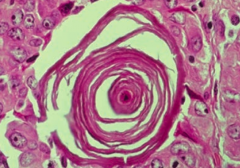
Laminated, concentric, calcific spherules
|
|
|
What are the causes of psamomma bodies?
|
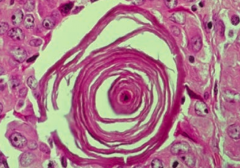
PSaMMoma bodies:
- Papillary carcinoma of thyroid - Serous papillary cystadenocarcinoma of ovary - Meningioma - Malignant mesothelioma |
|
|
What are the most common causes of cancer in males?
|
- Prostate (32%)
- Lung (16%) - Colon / rectum (12%) |
|
|
What are the most common causes of cancer in females?
|
- Breast (32%)
- Lung (13%) - Colon / rectum (13%) |
|
|
What are the most common causes of cancer mortality in males?
|
- Lung (33%)
- Prostate (13%) |
|
|
What are the most common causes of cancer mortality in females?
|
- Lung (23%)
- Breast (18%) |
|
|
How has lung cancer incidence changed in males and females?
|
- Dropped in men
- Not changed significantly in women |
|
|
What are the top two leading causes of death in US?
|
- 1st = Heart Disease
- 2nd = Cancer |
|
|
What are the common sites of metastasis?
|
- Brain
- Liver - Bone |
|
|
What are the most common tumors that metastasize to the brain?
|
Lung > Breast > Genitourinary > Osteosarcoma > Melanoma > GI
|
|
|
How common are brain tumors from metastasis?
|
50% of brain tumors are from metastasis
|
|
|
What is the typical appearance of brain tumors from metastasis?
|
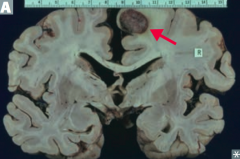
Multiple well-circumscribed tumors at gray/white matter junction
|
|
|
What are the most common tumors that metastasize to the liver?
|
Colon >> Stomach > Pancreas
|
|
|
What are the most common sites of metastasis after the regional lymph nodes?
|
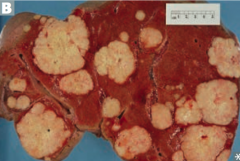
Liver and lung after the regional lymph nodes
|
|
|
What are the most common tumors that metastasize to the bone?
|
Prostate, Breast > Lung > Thyroid
|
|
|
Where do metastases to the bone preferentially affect?
|
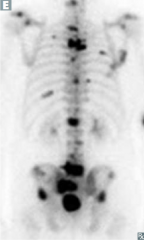
Whole-body bone scans show tumor predilection for axial skeleton
|
|
|
What are the characteristics of bone metastases from the prostate?
|
Osteoblastic
|
|
|
What are the characteristics of bone metastases from the breast?
|
Osteoblastic and Osteolytic
|

